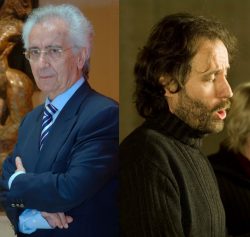The world’s best performers of polyphony pay homage to Vivanco’s superb music

 In memoriam Dámaso García Fraile (1936- 2021) and Dirk Snellings (1959- 2014)
In memoriam Dámaso García Fraile (1936- 2021) and Dirk Snellings (1959- 2014)
During the months of November and December 2002, the wonderful vocal ensemble
Capilla Flamenca joined forces with the cornets and sackbuts ensemble
Oltremontano in the Irish College Chapel of Lovaine to record a selection of motets of the Ávila composer Sebastián de Vivanco. The choice of
Capilla Flamenca and
Oltremontano to perform these extraordinary works was not accidental. Musically, few artists could be better entitled than these two universally acclaimed ensembles to revive these beautiful motets. Besides, it was also Artus Taberniel, the Antwerp printer, based in Salamanca, who published three of Vivanco's books of polyphony that have reached us. And no more appropriate than the
Capilla Flamenca, whose name was taken from the famous chapel formed by Charles I of Spain, who after leaving the Netherlands in 1517, chose some of his best musicians there to join him on his trip to Spain.
When
Dirk Snellings, founder and director of
Capilla Flamenca, contacted
José Carlos Cabello, the artistic director of
Cantus, to ask him to coordinate some aspects of the overall production of the recording and the eventual publication of the resulting CD, between them arose a friendship that lasted until
Snellings died in 2014. The original edition of the CD, which uses the transcription of
Dámaso García Fraile (2001) was published by the
Foundation Las Edades del Hombre in 2003 to accompany the exhibition
The Tree of Life, held in Segovia (in whose cathedral also served Vivanco) that very year. It was never marketed or distributed regularly. At the beginning of his illness,
Dirk Snellings asked
José Carlos Cabello to prepare a reissue of this album for
Cantus, as beautiful and complete as the music of Vivanco and the performances of
Capilla Flamenca and
Oltremontano deserved.
Dr. Javier Marín (of University of Jaén), a specialist in Vivanco music, was commissioned to write and coordinate new program notes. The dazzling result is now finally available worldwide as a tribute to Sebastián de Vivanco and of course to
Dirk Snellings as well, who as a conductor of his
Capilla Flameca recorded almost 40 absolutely essential albums (this Vivanco was, indeed, his only recording of the music of a single Spanish composer).
Although musicologists have always recognized the quality of the music of Vivanco, only recently theyhave deepened in his life and work, mostly thanks to scholars like
Bruno Turner, Dean Neuernberger, Dámaso García Fraile, Jorge Martín, Javier Marín and
Ana Sabe. Vivanco apparently was born in Ávila, coinciding with Victoria as a choirboy in the cathedral. Comparing the work of each other is always tempting, but Vivanco, who always remained in Spain, must be placed in relation to other composers such as Alonso Lobo, Juan Esquivel or Alonso de Tejeda. Despite not having traveled to Italy, Vivanco exhibits a good knowledge of the most cutting-edge trends of his time adapted to the Castilian tradition and his motets provide a good insight into the changes in the Spanish music with the turn of the century.
The readings proposed by
Capilla Flamenca and
Oltremontano are extraordinary. Both in the most intimate motets and in the most exultant pieces, they explore all the expressive and technical possibilities of the works. Accordingly, they highlight the daring harmonies that include increased intervals, underlining the sudden changes of rhythm so typical of the
seconda prattica, and give great clarity in the imitative passages of the
incipits of each phrase ... Alternating purely
a capella performances of some motets with instrumental versions, or seeking to blend voices and instruments, they are capable to obtain really fascinating colors. Surely, performances of the highest stature for a music of great finesse and quality, which reconciles modernity and tradition in an era of profound transformations.

Sebastián de Vivanco: Motecta
- Capilla Flamenca artistic director: Dirk Snellings
Marnix de Cat, Gunther Vandeven, countertenors
Jan Caals, tenor
Lieven Termont, baritone
Dirk Snellings, bass
Oltremontano (Wim Becu, director):
Wim Becu, Simen Van Mechelen, sackbuts
Fiona Russel, cornet
Wouter Verschuren, dulzian
Aditional information
- Total time total 54:12Booklet with a newly-written article by Dr. Javier Marín, Universidad de Jaén
Recording place Irish College Chapel, Leuwen (BE), 2002
Engineering and digital edition Jo Cops
Production Paul Belaerts
Executive production Las Edades del Hombre, Capilla Flamenca & José Carlos Cabello
Design and booklet cordination José Carlos Cabello
Cover Alejandro de Loarte, "El milagro de San Bernardo" (ca. 1620), Museo del Prado, Madrid. All rights reserved.
 In memoriam Dámaso García Fraile (1936- 2021) and Dirk Snellings (1959- 2014)
In memoriam Dámaso García Fraile (1936- 2021) and Dirk Snellings (1959- 2014)

![C 9649 SEBASTIÁN DE VIVANCO: SANCTI ET JUSTI (MOTECTA, 1610) [11,99 Euro]](http://www.cantus-records.com/wp-content/themes/kingsize/timthumb.php?src=http://www.cantus-records.com/wp-content/uploads/2016/04/C-9649_front.png&w=289&h=247&zc=1&q=100)
![C 9649 SEBASTIÁN DE VIVANCO: SANCTI ET JUSTI (MOTECTA, 1610) [11,99 Euro]](http://www.cantus-records.com/wp-content/themes/kingsize/timthumb.php?src=http://www.cantus-records.com/wp-content/uploads/2016/04/C-9649_back.png&w=314&h=247&zc=1&q=100)




